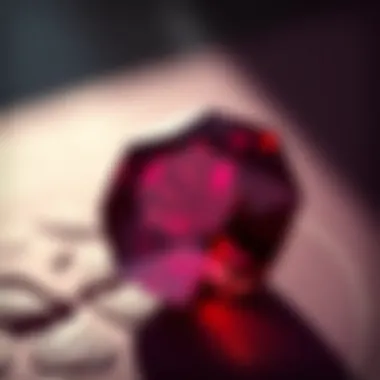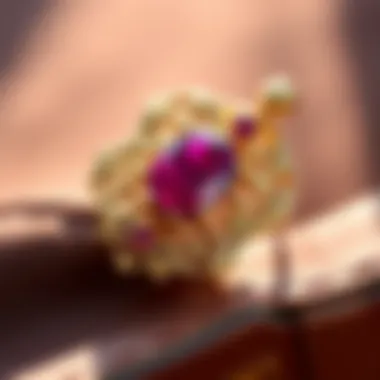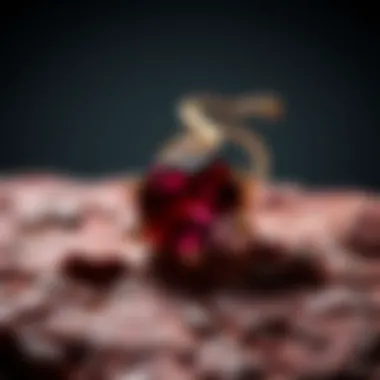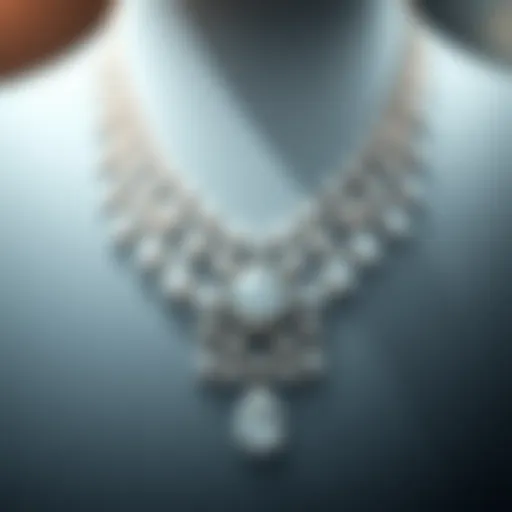Exploring the Ruby: Birthstone of July 16th


Intro
Born from the fiery depths of the Earth, the ruby glows with an intensity that has captivated humanity for eons. As the birthstone for individuals born on July 16th, rubies embody passion, power, and a certain mystical quality that lends them a unique place in both history and modernity. This article embarks on a journey through the fascinating world of rubies, unraveling their distinct characteristics, exploring their historical background, and examining their various applications across the ages.
In this exploration, we shine a light on the origins of this stunning gem, unpack its metaphysical attributes, and delve into the cultural significance of rubies over time. Moreover, we will provide valuable insights into recognizing genuine rubies, as well as discussing their reputed healing properties and significance in astrology. Whether you are a gemstone enthusiast, a dedicated collector, or simply someone intrigued by this vibrant stone, prepare to dive deeper into the captivating essence of rubies.
Gemstone Overview
Description of the gemstone
Ruby, known scientifically as corundum, is a red gemstone that shines brightly, thanks to its striking chromium content. The word "ruby" originates from the Latin word "ruber," meaning red. This stone is famed for its rich, blood-red hue often described as "pigeon blood" when it exhibits the perfect tone of brightness and darkness. The ruby’s color can range from pinkish-red to a deeper crimson, making each piece unique, almost like the fingerprints of nature.
Physical properties
One of the remarkable attributes of rubies is their toughness. It ranks a solid nine on the Mohs hardness scale, just a notch below diamond. This exceptional hardness makes rubies ideal for various jewelry applications. Their dazzling brilliance is a result of their high refractive index and incredible dispersion of light. Furthermore, rubies carry a specific gravity of 3.97 to 4.05, allowing them to have a distinctly heavy feel compared to other gemstones of similar size.
To better understand rubies, let’s look at some key physical characteristics:
- Color: Ranges from pinkish-red to deep crimson.
- Hardness: 9 on the Mohs scale.
- Specific Gravity: 3.97 - 4.05.
- Refractive Index: 1.76 - 1.77.
Their natural beauty and durability make rubies highly sought after in the jewelry market. With heat treatment becoming a common practice, many rubies exhibit enhanced colors and clarity, although enthusiasts should always be wary of treatments that may alter the stone's inherent qualities.
Healing Properties
Metaphysical attributes
Throughout history, rubies have not only been admired for their visual appeal but also for their alleged metaphysical properties. Many cultures believe that rubies possess potent energy properties that can help amplify emotions, particularly those linked to love and passion. An old belief claims that wearing a ruby can enrich one's life experience, encouraging positivity, and helping to bring one's dreams to fruition.
Common uses in holistic practices
In the realm of holistic practices, rubies are often associated with the root chakra, symbolizing vitality and strength. Enthusiasts might use rubies during meditation to boost confidence and self-worth. Some common applications include:
- Carrying a ruby in your pocket to inspire courage and motivation.
- Placing a ruby under your pillow to promote vivid dreams and protection during sleep.
- Wearing ruby jewelry to enhance emotional well-being and personal power.
The allure of rubies goes beyond visual appeal; their energetic properties render them significant in various spiritual and holistic practices.
Prelims to July Birthstones
When folks think about birthstones, they often consider them just colorful gems connected to specific months. However, birthstones hold a deeper significance—one that intertwines culture, history, and personal identity. This article takes a closer look at July birthstones, particularly the ruby, which is renowned for its rich hue and symbolic meanings.
The ruby is not merely a beautiful stone; it is a symbol of passion, love, and courage. These attributes add layers to its significance, making it beloved by many throughout history and across various cultures. Understanding the importance of July birthstones allows individuals to connect more personally with the gems they might choose to wear or gift, enhancing their meaning and value.
Significance of Birthstones
Birthstones go beyond aesthetic appeal. They often represent a person's character traits and even the different seasons of life. For instance, rubies are linked to warmth and enthusiasm, echoing the warmth of July's summer sun. Each stone resonates with unique properties, believed by many to bring good luck or protection to the bearer.
With a richer understanding of a birthstone comes a more nuanced approach to jewelry and personal adornment. They can serve as meaningful gifts, fostering a deeper connection between the giver and recipient. Whether it's a family heirloom or a simple gift, these stones can being a long-lasting bond.
Overview of July Birthstone
The ruby, with its striking red color ranging from deep crimson to lighter pinkish hues, is fascinating. Many people think the deeper the red, the more valuable the stone, but various factors contribute to a ruby's worth. For instance, clarity, cut, and the origin of the stone all play vital roles in its valuation.
In addition to their beauty, rubies have a fascinating history. They have been treasured by royalty and are often seen in grand jewelry pieces, enhancing their allure. Furthermore, rubies also connect to various myths and legends, which enrich their narrative and significance. Recognizing the depth of the ruby's story enables enthusiasts to appreciate their allure and significance even more.
In summary, exploring July birthstones—especially the ruby—opens up a treasure trove of meaning, history, and cultural relevance. It's not just about the gemstone; it's about everything it represents and the emotions tied to it.
The Ruby: July's Birthstone
The ruby holds a special place in the world of gemstones, as it embodies not just radiant beauty but also a wealth of historical significance and cultural importance. Judging by its deep red color, the ruby has long been seen as a symbol of passion, vitality, and even protection. This section aims to explore the importance of rubies, considering their historical context, the unique physical properties that set them apart, and what makes these gemstones so sought after by enthusiasts worldwide.
Historical Background of Rubies


Rubies have a rich history that transcends cultures and civilizations. According to numerous historical sources, ancient cultures believed that rubies could protect warriors in battle. For example, in ancient Burma, warriors wore rubies embedded in their skin, confident that this gemstone would ensure victory. Likewise, in various cultures, rubies were regarded as a talisman against evil, often placed in homes, amulets, or jewelry to ward off negativity.
Moreover, throughout the Middle Ages, the ruby's esteemed status rose even higher. It was often associated with nobility and was a frequent choice in royal regalia. Emperors and kings adorned themselves with rubies to signify their power and prestige. The allure of this gemstone continues today, represented in the engagement rings of many couples and standing as a captivating testament to love.
Physical Properties of Rubies
Rubies are prized not only for their striking appearance but also for their detailed physical characteristics. These properties play a significant role in their appeal, influencing everything from pricing to durability.
Color Spectrum
The color of rubies is their most defining feature. Most people associate rubies with a vivid red hue, but they can also range from pinkish-red to blood-red tones. Its vibrant color arises mainly due to chromium content within the stone. The presence of chromium gives rise to that remarkable hue, often making rubies more dazzling than other red gemstones, like garnets.
Interestingly, the depth of color also affects a ruby's value. A deep, saturated red generally garners a higher price tag, as it's more desirable among collectors and gem enthusiasts. However, not everyone might prefer the darker shades; lighter, rose-colored rubies have their own charm and appeal as well.
Clarity and Cut
When it comes to clarity, rubies often contain inclusions, which can either enhance or diminish their value. Unlike diamonds, rubies with certain inclusions, known as "silk," can be prized for their unique characteristics. However, it is the clarity combined with an expert cut that allows the ruby to truly shine.
The cut of the ruby determines how well the light interacts with it; an expertly cut ruby will display an alluring sparkle and brilliance. While some cuts like the traditional oval or round are popular, unique custom cuts can also make a ruby stand out, drawing the eye and making it a focal point in jewelry designs.
Hardness and Durability
Rubies, classified as a variety of the mineral corundum, boast remarkable hardness, scoring a 9 on the Mohs scale. This makes them one of the hardest gemstones, second only to diamonds. Their durability means they can withstand daily wear, making them an excellent choice for rings or bracelets that are prone to bumps and scratches.
However, while rubies are quite resilient, proper care is still necessary. Though they can take a beating, mishandling or exposure to harsh chemicals can affect their luster over time. With the right care, a ruby can last generations, often becoming treasured heirlooms.
In summary, the ruby is not just a striking gem; its historical significance, vibrant color spectrum, knowledgeable cuts, and impeccable durability make it a valuable addition to any gemstone collection. As we dive further into the various attributes of this remarkable stone, our understanding of its charm will undoubtedly deepen.
Metaphysical Properties of Ruby
The metaphysical properties of ruby hold a prominent place in both spiritual and holistic communities. This section aims to unpack these dimensions, focusing on the ruby’s unique importance in fostering energy transformation, promoting emotional stability, and nurturing physical vitality. Understanding the metaphysical attributes of ruby is essential for both gemstone enthusiasts and those seeking a deeper connection to their personal and spiritual journeys.
Spiritual Significance
The ruby, often associated with the sun, embodies potent energy widely regarded as a symbol of passion and courage. Within the spiritual realm, many believe that rubies increase an individual's life force, fostering deep emotional healing and spiritual enlightenment. Rubies are thought to promote strong leadership qualities and decisiveness. They can assist one in overcoming barriers and doubts, aligning the spirit with self-belief and clarity.
In various cultures, the ruby's vibrant hue represents not just love but also protection. The notion that the ruby protects one from negative energies is particularly compelling. Those who wear or carry this gemstone often find it serves as a shield, empowering them to pursue their life paths confidently.
Emotional and Physical Healing
Ruby does more than just enhance spiritual practices; it also plays a crucial role in emotional and physical healing. Many advocates of gemstone therapy emphasize ruby’s benefits in nurturing one’s mental wellness and vitality. This connection to well-being can be particularly appealing to those recovering from trauma or seeking emotional balance.
Promoting Vitality
Promoting vitality through ruby is an alluring idea for many. A key characteristic of ruby in this context is its reputation for boosting overall life force. By stimulating the root chakra, ruby is said to help ground individuals, making them feel more connected to themselves and the earth.
The unique feature here is its ability to cultivate energetic transformation, offering a burst of enthusiasm and motivation. Advocates will often remark how wearing or engaging with ruby can invigorate one's daily activities. It is seen as a beneficial aid for those striving to harness their physical potential. However, while ruby's energetic properties are potent, it's essential to note that each individual's experience can differ significantly—what sparks vitality in one may not have the same effect on another.
Boosting Confidence
Confidence is another dimension where ruby shines significantly. Often touted as the gemstone for those seeking empowerment, ruby is believed to help individuals break through self-doubts and take action. Its compelling energy resonates with the heart, often inspiring enhanced self-esteem and assertiveness.
The vital feature of this aspect lies in its capacity to push through fears, enabling individuals to embrace their true potential actively. This makes ruby a sought-after stone for performers, leaders, and anyone facing challenges that demand resilience. However, it’s worth considering that the confidence gained through ruby may also bring forth introspective challenges; one might confront aspects of the self that require addressing.
"A ruby's energy can ignite the spark needed to take bold steps in life, while simultaneously allowing for profound self-reflection."
Several communities discuss various experiences related to rubies on platforms like Reddit or jewelry forums for those interested in collective insights.
Astrological Associations of Ruby
Rubies, with their vibrant crimson hues and long-standing legend, not only captivate the eye but also intrigue those who delve into the astrological realm. In this section, we will explore the deep connection between rubies and astrology, highlighting the benefits, perceptions, and implications of this relationship. For many enthusiasts, understanding the astrological significance of rubies offers a more profound insight into their metaphysical properties and personal connections. This relationship does not merely exist on the surface but gets intertwined with beliefs that date back centuries.
Zodiac Signs Linked to Ruby


Rubies are primarily associated with the zodiac sign of Cancer, which governs individuals born between June 21 and July 22. This fiery gemstone resonates with the emotional and intuitive traits often attributed to Cancer individuals. Here are some reasons why rubies are linked to this sign:
- Emotional Expression: Cancers are known for their deep emotional well-being. Rubies, symbolizing love and passion, serve to amplify these feelings, encouraging Cancers to express their emotions freely.
- Protection and Security: The protective nature of rubies aligns with the Cancer characteristics of loyalty and nurturing. Many believe that wearing rubies can provide a sense of safety, helping to guard against negative energies.
- Strength and Vitality: As Cancers often seek strength in their connections, rubies offer support and resilience, nurturing personal relationships and enhancing self-confidence.
Though the Cancer zodiac is the most prominent, rubies also resonate with Leo and Sagittarius. Leos, ruled by the sun, find a harmonious connection with the ruby’s brightness and strength, which reinforces their natural leadership qualities. Meanwhile, our adventurous Sagittarians can utilize the ruby's vibrant energy to boost creativity and overcome hurdles.
Using Ruby in Astrology
In astrology, the application of rubies extends far beyond mere adornment. Their use encompasses various practices aimed at enhancing one’s life, grounding emotional well-being, and boosting spiritual journeys.
- Wearable Talismans: Many believe that wearing ruby can elevate one’s personal energy. It is thought to enhance the wearer’s magnetic appeal, drawing in positive experiences and fulfilling relationships. Those under the Cancer zodiac may wear ruby rings or necklaces as a charm for emotional stability.
- Astrological Remedies: For individuals seeking to balance their astrological charts, rubies are often recommended as a remedy for harnessing positive energies. Astrologers suggest incorporating rubies in one’s personal space or during meditation practices to foster alignment with one’s inner self.
- Ritualistic Practices: From lighting candles to creating manifesto lists, incorporating rubies in rituals can elevate one's intent during astrological events, such as full moons or new beginnings.
Using rubies thoughtfully in accordance with one’s birth chart can potentially lead to enhanced life experiences. It’s worth noting, however, that astrological interpretations can vary widely among traditions and practitioners, meaning individual experiences may differ considerably.
The essence of rubies goes beyond the physical realm, weaving a narrative that intertwines spirituality, emotion, and cosmic energies.
By examining the relationship between rubies and zodiac signs, we gain enhanced insight into how these stones can influence and reflect our lives, especially for those born under Cancer, Leo, and Sagittarius. The deeper connection to astrology not only reflects personal attributes but fosters a sense of understanding of how gems, particularly rubies, can truly become a part of one's identity.
Cultural Significance of Ruby
The ruby's cultural significance extends far beyond mere aesthetics; it embodies rich narratives, values, and beliefs that have shaped societies across the globe. Throughout history, rubies have held a revered status, often associated with power, passion, and protection. Their vibrant red hue is not just visually striking but also symbolically potent, steeped in meanings that resonate profoundly in various cultures.
Ruby in Ancient Civilizations
In ancient history, rubies found their place in many influential societies. The Indian culture, for instance, elevated this gemstone on a pedestal, believing it could bring peace and protection from enemies. Historical texts point out that rubies were often worn by warriors, not just for adornment, but as a talisman against harm.
The Egyptians, on the other hand, considered the ruby a symbol of the sun and life force. It was buried with pharaohs to accompany them in the afterlife, indicative of its supposed ability to grant eternal life. Even in ancient Burma, warriors wore rubies as part of their armor, convinced that these stones would make them invincible in battle. The strong belief in the ruby's abilities reflects the immense value society placed on it in ancient times.
Moreover, the connection of rubies with the divine is notable in various religions. Buddhists regard rubies as sacred, stemming from the belief that the stone represents the fundamental essence of life. In ancient texts, it's written that possessing a ruby could grant insight into one’s own destiny. Such narratives not only highlight the ruby's physical allure but raise it to a spiritual or metaphysical stature.
Modern-Day Value and Affection for Rubies
Today, the ruby remains a symbol of love and passion, especially within the context of romantic partnerships. It is a popular choice for engagement and anniversary rings due to its association with strong emotions, particularly love infused with passion. This perception is ingrained in many cultures, making rubies the stone of choice for celebrating significant milestones in relationships.
From a commercial standpoint, rubies are deemed one of the most valuable gemstones, often commanding higher prices than diamonds due to their rarity and demand. Collectors and jewelers alike seek out exceptional stones that show remarkable color and clarity.\n In contemporary culture, rubies find themselves embedded in various artistic expressions and media, cementing their status as cultural icons. Whether they're gracing the fingers of royalty or being featured in cinematic portrayals of wealth and glamour, rubies have maintained their allure.
The End
In sum, the cultural significance of rubies transcends generations and borders, weaving a rich tapestry of historical narrative and modern appreciation. From ancient warriors to today's lovers, these gemstones continue to be cherished not only for their beauty but for what they represent—love, strength, and a connection to something greater.
Identifying Authentic Rubies
Identifying authentic rubies is a critical aspect for any gemstone enthusiast, collector, or jewelry designer. The value of rubies can vary tremendously based on their quality and authenticity. It’s not merely a question of aesthetics; rather, it involves understanding the nuances that differentiate genuine rubies from their synthetic or imitation counterparts. Knowing these differences can ensure you make informed purchases and investments, preserving the integrity and beauty that this stunning gemstone represents.
Several factors come into play when assessing rubies. These include color, clarity, cut, and carat weight. When combined, they help establish the overall value and desirability of the stone. Diving deeper into the key characteristics can also arm you with the necessary insights to navigate through the gem marketplace with confidence.
"Purchasing a ruby is an investment in beauty, history, and emotional significance; knowing how to identify an authentic one can make all the difference."
Key Characteristics to Look For
When examining rubies, highlighting their distinctive features is essential. Here are some key traits you should keep an eye out for:
- Color: Rubies exhibit a rich red hue, often described as pigeon blood for the most prized stones. This vivid color results from chromium content and contributes significantly to its value. The absence of brown or purple undertones generally signifies a top-quality ruby.
- Clarity: Genuine rubies often contain natural inclusions—a characteristic known as "silk"—that can offer insight into their authenticity. Look for these and steer clear of overly pristine specimens, which may be synthetic.
- Cut: The quality of the cut can affect light performance and, subsequently, the ruby's brilliance. A well-cut ruby should display a symmetry that allows it to reflect light beautifully.
- Carat Weight: Weight matters. Larger stones tend to be rarer and are typically sold at a higher price. However, size alone isn’t an indicator of quality; ensure to assess other characteristics as well.
Familiarizing yourself with these traits will go a long way in spotting an authentic ruby versus an imitation.
Common Imitations and How to Spot Them
The marketplace is teeming with imitations ranging from synthetic rubies to other gems like pink sapphires or glass substitutes. Knowing how to distinguish between the genuine article and its imitations is crucial:
- Synthetic Rubies: Created in labs, synthetic rubies can mimic the appearance of natural stones but lack the unique inclusions often present in authentic rubies. Look for a uniformity that seems too flawless—often a telltale sign of a synthetic gem.
- Glass-Filled Rubies: These rubies have been treated to enhance clarity, often making them appear more vibrant. One way to spot them is observing under magnification; signs of bubbles or residue can indicate that the ruby has been filled with glass.
- Pink Sapphires: While they may seem similar, pink sapphires lack the deep red tint often found in genuine rubies. Comparing shades can reveal valuable insights.


Enhancing your knowledge as a buyer prepares you to approach the market confidently. Your awareness about authentic rubies not only improves your chances of acquiring genuine pieces but also nurtures a deeper appreciation for this remarkable gemstone.
Caring for Ruby Gemstones
Caring for ruby gemstones is not just a practice; it’s an essential commitment for those who appreciate their enduring beauty and historical significance. Unlike other gemstones, rubies are unique not only in color but also in the intricate symbolism they carry. Fostering an awareness of how to best care for these gemstones extends their luster and maintains their value. It provides both a tangible and sentimental connection to this fiery stone.
Cleaning and Maintenance Tips
When it comes to cleaning rubies, simplicity is key. Many people may think they need complex solutions, but the best approach often involves gentle methods. Here are some straightforward tips:
- Use Warm Soapy Water: Mix a few drops of mild dish soap with warm water and soak your ruby for about 15 to 20 minutes. This can help lift any dirt or oils.
- Soft Brush: After soaking, use a very soft brush, such as a toothbrush with bristles designed for delicate cleaning. Brush gently around the gemstone to remove residue.
- Rinse and Dry: Rinse the gemstone under lukewarm running water. Ensure it’s free from any soap residue. For drying, a soft, lint-free cloth is ideal to avoid scratches.
"Proper care will make your rubies shine bright, like the first blush of dawn in the sky."
Proper Storage Techniques
Storing rubies correctly is crucial for their longevity. If not stored properly, they can scratch or chip, taking the dazzle out of these precious stones. Here’s what you should consider:
- Separate from Other Jewelry: Always keep your ruby jewelry separate from other pieces. The hardness of rubies can scratch softer gemstones. Using a fabric-lined box or a separate compartment works wonders.
- Avoid Humidity: Keep rubies in a cool, dry place. Humidity can affect the integrity of the setting and the stone itself.
- Regular Inspection: Periodically check your ruby settings to ensure that everything is secure. A loose stone can easily become lost or damaged.
In caring for ruby gemstones, a little effort goes a long way. Following these tips not only preserves the beauty of the stone but also enhances the joy of owning such a remarkable piece of nature's art.
Ruby in Jewelry Design
When it comes to jewelry, rubies hold a revered position, often referred to as the king of gemstones. Their vibrant red hue not only embodies passion and courage but also symbolizes protection and love. The significance of rubies in jewelry design is manifold, encompassing not just aesthetic appeal but also historical and cultural dimensions.
The use of rubies in jewelry is deeply rooted in tradition. Historically, these gemstones were considered the ultimate talismans, believed to bring good fortune and ward off evil. Today, they continue to captivate both jewelers and audiences alike.
Popular Jewelry Styles Featuring Rubies
Rubies can complement a variety of jewelry designs through their striking color. Here are some of the popular styles where rubies shine:
- Engagement Rings: Many couples opt for rubies instead of the traditional diamond for their engagement rings. This unique choice emphasizes individuality and adds a touch of vibrant color to a timeless piece.
- Vintage Styles: Ruby-encrusted vintage pieces often speak to an era that treasures craftsmanship and timeless beauty. Art Deco and Victorian styles, in particular, frequently feature rubies intermixed with diamonds and other gemstones, creating a stunning contrast.
- Statement Necklaces: Large rubies set in elaborate settings can transform an ordinary necklace into a jaw-dropping statement piece. These are often favored in formal occasions or owned by collectors.
- Bracelets and Earrings: Wearing rubies as accents in bracelets or earrings allows individuals to enjoy their elegance in more casual settings while preserving their charm.
Choosing the Right Setting for Rubies
Selecting the right setting is crucial when it comes to incorporating rubies into jewelry. The setting not only elevates the stone's beauty but also protects it. There are a few key considerations to keep in mind when deciding:
- Metal Choice: Gold and platinum settings are the most popular as they not only complement the deep red color of rubies but also ensure durability. The choice of metal can influence the overall aesthetic, with yellow gold lending warmth and white gold adding a modern flair.
- Style and Design: The body of the jewelry should harmonize with the ruby's brilliance. For instance, a prong setting can showcase the stone's size and color effectively, while a bezel setting might enhance a more contemporary look while providing added protection.
- Stone Quality: The clarity and color of the ruby should guide the design process. A high-quality ruby may be the focal point framed by smaller accent stones, whereas a more subdued ruby may blend in with intricate designs to draw attention subtly.
Rubies are not merely decorative elements; they carry deep emotional resonance and spiritual significance. They are often viewed as powerful gemstones that imbue the wearer with energy and vitality. Therefore, when designing jewelry that features rubies, it's vital to consider these aspects to create a meaningful piece.
"Rubies are a reflection of the fiery spirit of those who wear them, making each piece not just an accessory but a part of one's identity."
In summary, the role of rubies in jewelry design is a beautiful amalgamation of tradition, style, and emotion. Each piece tells a story, whether it's about love, compassion, or courage. The careful selection of styles and settings ensures that the unique qualities of the ruby are brought to the forefront, allowing its brilliance to enchant anyone who beholds it.
Culmination: The Lasting Allure of Ruby
As we wrap up this exploration, it’s clear that the ruby is more than just a stunning piece of jewelry—it embodies a rich tapestry of history, culture, and spiritual significance. Its vibrant hue and durability place it among the esteemed gemstones cherished throughout the ages. The ruby's allure is not only in its visual appeal but also in the stories it tells and its remarkable properties that link the past to the present.
Reaffirming Ruby's Status
The ruby has gained an iconic status, transcending the realms of mere decoration.
- Historically, it has been a symbol of power and passion, often associated with nobility.
- From the crowns of ancient kings to modern-day engagement rings, the ruby stands firm as a signifier of strong emotions and commitment.
Consider the deep red that signifies love and courage, drawing individuals not only towards its aesthetic but also the sentiments it represents. The gemstone is often referred to as the "king of gems," reflecting its position in the hierarchy of precious stones.
Moreover, with advancements in gemology, the ruby's value is continuously reaffirmed. Collectors keep an eye on the ever-fluctuating market trends, as natural rubies remain particularly sought after, often fetching prices that wow even seasoned gem traders.
Final Thoughts on Ruby's Influence in Gemology
In the gemological landscape, the ruby’s significance is undeniable. It serves as a benchmark against which other gemstones are measured. The contemporary appreciation of sapphires, garnets, and even synthetic stones often draws comparisons back to rubies, underscoring how influential this gemstone remains.
Furthermore, ruby's impact extends into various fields, encompassing not just jewelry design but also wellness practices and artistic expression. The discussions surrounding its metaphysical properties—especially in emotional and spiritual healing—heighten its relevance in today’s holistic communities.
In essence, the ruby’s legacy is woven into the fabric of our culture. As gemstone enthusiasts, collectors, and jewelry designers, it’s crucial to recognize the multi-layered significance of the ruby. Investing time in understanding its history and properties not only enhances appreciation but also enriches the narrative surrounding this remarkable stone.
"Ruby isn't just a stone; it’s a lens into history and emotion, captivating the hearts of many across generations."







